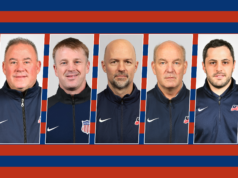| During last year’s Stanley Cup finals, former NHL coach Jacques Demers wrote a piece in USA Today talking about the length of players’ shifts on hockey’s biggest stage.
According to Demers’ tabulations, five-time Norris Trophy winning defenseman Nicklas Lidstrom played more than 28 minutes a game, but his shifts averaged 44 seconds in length. Henrik Zetterberg’s shifts ran about 43 seconds while Pavel Datsyuk was on the ice for an average of 39 seconds before grabbing some pine. Conversely, there were several noted situations where Evgeni Malkin of the Pittsburgh Penguins was on the ice for more than a minute and was clearly out of gas by the end of his shift. Keep in mind that by the time the Stanley Cup finals roll around these players have put their bodies through the ringer by playing more than 100 games, not to mention the physical and mental wear and tear of battling hard for every inch of NHL ice. The question is, if short shifts are good enough for the NHL’s golden goose, shouldn’t the same philosophy be good enough for the youth hockey gander? It’s a coach’s responsibility to monitor and enforce the length of a player’s shift, not only to give all players ample playing time, but also to guard against short-term and long-term fatigue. “It’s not just the shift, but it’s the shift within a game, the game within a week, the week within a month and the months within a season,” says Paul Cannata, head coach at Milton (Mass.) Academy. “If you’re constantly over extending yourself, it has consequences on the game and the season. If you ride your horses too hard and too long too early in a game, they may not have anything left during crunch time.” Coaches will site numerous variables that play into their decision to keep a player on the ice for an extended period of time, from the quality of lines to the number of kids on the bench to a critical point in a game that calls for top players to be matched up against top opponents. Some coaches point out that shifts tend to be a little longer, particularly at the Mite and Squirt ages because they display the same traits as the Energizer Bunny and keep going and going and going on the ice. As they move up the developmental ladder, most coaches advocate that elite players should not be on the ice for more than 45 seconds for a shift, giving it their all before returning to the bench to rest and recover. Once a player reaches that plateau of ice time, not only do they tend to show outward signs of being fatigued, the lactic acid that builds up in the legs becomes more difficult to deal with. “When a player overextends himself on one shift, it will be more difficult to recover for the next shift, and the shift after that,” says Ken Martel, a former coach with the National Team Development Program who now studies high performance training for USA Hockey. As a coach, if you have your kids play shorter shifts, you will dictate the tempo of the game because your players will have fresher legs. “What I find with my teams is that if they play long shifts the kids tend to pace themselves and don’t go all out,” says Mark Tabrum, director of USA Hockey’s Coaching Education Program. Every coach has his own philosophy on how much to play a team’s top players. But is a first-line player who is dead tired any better than a fresh fourth-liner when the game is on the line? “Shorter shifts early in the game will leave something left in the tank for the third period and overtime,” says Dan Brennan, manager of USA Hockey’s Coaching Education Program. “There’s nothing worse than a tired player out on the ice. He or she then leaves your team vulnerable.”
( By Harry Thompson
|






